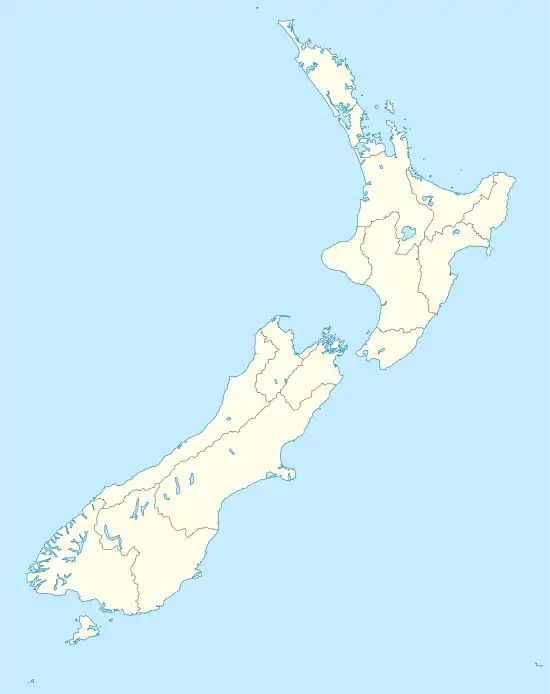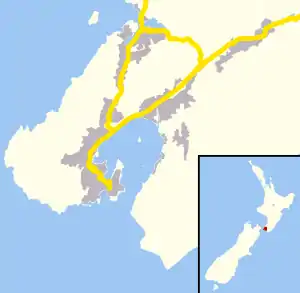Naenae
Naenae (/ˈnaɪnaɪ/, occasionally spelled NaeNae) is a suburb of the city of Lower Hutt, New Zealand. It lies on the eastern edge of the floodplain of the Hutt River, four kilometres from the Lower Hutt Central business district. A small tributary of the Hutt, the Waiwhetu Stream, flows through the suburb. Naenae has a population of around 8,000 people.
Naenae | |
|---|---|
Suburb | |
 Naenae | |
| Coordinates: 41.2002°S 174.9525°E | |
| Country | New Zealand |
| Local authority | Lower Hutt City |
| Population (2006[1]) | |
| • Total | 8,292 |
| Train station(s) | Naenae Railway Station |
| Avalon | Wingate | |
| Boulcott |
|
|
| Epuni |

Naenae's shopping centre contains an Olympic-size swimming-pool, built when New Zealand hosted an international diving championships. The pool has three diving boards. Originally open-air, the complex gained a roof due to overwhelming public support, making it accessible all year round. A hydroslide adjacent to the main pool attracts more people. The toddlers' paddling pool remained open-air for a few years more. The pool closed in April 2019 due to earthquake concerns.[2]
Naenae or nae-nae is a translation from the Māori, meaning "mosquito" or "sandfly", recalling a time prior to the draining of the area, when the mosquito population predominated.
Setting
Naenae occupies a basin and the lower slopes of the Eastern Hutt Hills in the upper reaches of the Waiwhetu Stream catchment area.[3]
History
As Lower Hutt expanded after the end of World War II in 1945, the Labour Party government under Peter Fraser selected Naenae as an ideal site to become a "designer community", a model suburb of sorts, where a suburban state-housing estate would complement a substantial shopping centre. This community centre would serve as a social hub for the greater area. The planners hoped to encourage nuclear-family life in such a scheme. Due to the increasing urbanisation of New Zealand, demand for housing outstripped the need for such centres, leaving the scheme only partially realised.
Ernst Plischke, an Austrian architect, designed plans for the new community centre between 1942 and 1943. However, government architect Gordon Wilson later drastically changed the design.[4][5]
Naenae Railway Station (opened 1946), on the Hutt Valley section of the Wairarapa Line, adjoins Naenae's shopping centre.
Naenae's post-modern Post Office building (officially opened in 1966, closed as a postal centre in 2016) pays homage to the Art Deco era Main Post Office in Lower Hutt town centre.
A re-zoning of Naenae made it partly industrial in the 1960s, but it remained principally a residential area. At its peak, Naenae boasted two manufacturers with strong Dutch connections:
- Philips, which produced televisions and radios, see pictures here. This industry closed down during the 1980s: Resene Paints occupied the buildings as of 2007.
- Rembrandt Suits Ltd, formed following the Second World War by Dutch tailors. It now exports mainly to Australia, and has major contracts throughout the world.
Education
Naenae has four schools:
- Naenae School is a state contributing primary (Year 1–6) school serving the southern half of the suburb. It has 274 students as of March 2020.[6]
- Rata Street School is a state contributing primary (Year 1–6) school serving the northern half of the suburb. It has 314 students as of March 2020.[6]
- St Bernadette's School is a state-integrated Catholic full primary and intermediate (Year 1–8) school. It has 113 students as of March 2020.[6]
- Wa Ora Montessori School is a state-integrated Montessori composite (Year 1–10) school. It has 269 students as of March 2020.[6]
State intermediate students (Year 7–8) and secondary students (Year 9–13) are served by Naenae Intermediate School and Naenae College respectively, which despite their names are located in the adjacent suburb of Avalon.
References
- Hutt City Council - 2006 Hutt City Demographic Profile Archived 2008-12-27 at the Wayback Machine Retrieved: 7 January 2009
- "Naenae Pool closed over earthquake concerns". April 2019.
-
"Review of Valley Floor Reserves: Naenae". PAOS. July 2014. p. 8. Retrieved 2018-09-19.
Naenae is dominated visually by the eastern hills, and Waiwhetu Stream and its tributaries are a key natural feature and connecting element.
- Bowman, Ian (2008). The challenge of change: dealing with the legacy of the modern movement. Translating the New Old-World into the New New-World - Reassessing Ernst Plischke's plan for Naenae, Lower Hutt, New Zealand. ISBN 9781586039172.
- "The Importance of Being Ernst". New Zealand Historic Places Trust.
- "New Zealand Schools Directory". New Zealand Ministry of Education. Retrieved 26 April 2020.